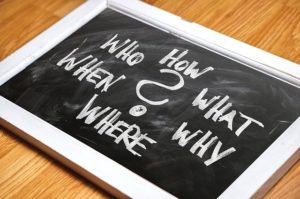People hate writing about themselves. In my nearly 25 years of working in marketing and communications, I have yet to meet a single professional who declared an eager desire to write about themselves. Nonetheless, it’s an inevitable task you are bound to be cursed to tackle. Don’t fret. I’m here to help! Use my tips for writing your About page. Together, we’ll make the process as painless as possible. Let’s begin by defining your goal.
What is the goal of your About page?
When it come to content, it’s best to identify the goal of it before you even begin. Content goals normally fall in one of these categories:
- Inform
- Attract
- Persuade
What is your goal? Do you want to merely state the facts, captivate a new audience, or persuade the reader to do something? Know your goal and use it to influence your angle. Now, let’s think about your audience.
Who is the reader looking at your About page?
 Don’t be quick to think the audience viewing this page is your customer. Think about this: if I am at your website to buy some cute shoes you’re selling, I couldn’t care less about your About page. I’m there to shop!
Don’t be quick to think the audience viewing this page is your customer. Think about this: if I am at your website to buy some cute shoes you’re selling, I couldn’t care less about your About page. I’m there to shop!
However, if I’m a reporter from a fashion media outlet, and I’m looking to interview a leading footwear expert, before I reach out to you, I’m going to thoroughly read your About page to ensure you’re a viable source for my article.
Define your audience and create an About page that caters to their needs.
Decide on your keyword or keyword phrase.
This is super important. Do not skip this step. No matter your goal (inform, attract, or persuade), proper SEO must a part of your strategy. You want this page to be indexed by search engines and come up in search results when internet users are conducting searches related to your industry. Before you start typing the text of your About page, know in advance what your keyword or keyword phrase is.
Pick a person.
Will you write your About page in first person or third? There’s no real right or wrong answer for this. The answer really depends on your goal and audience. If you think the person reading your About page is the type of person who wants to be spoken to directly in a personal manner, then opt for first person.
Personally, I have always followed this rule-of-thumb:
- If the About page is for a company or organization and/or the founder or top executive of a company or organization, the About page should be written in third person.
- If the About page is for a single person, such as a blogger or freelancer, then the About page should be written in first person.
Again, there’s no real right or wrong answer. Go with what works for you and your brand. Just be sure to consider your audience. Now, let’s write your story.
The 5 Ws and 1 H
This is the basic stuff you learned in school regarding how to gather and present information. By sticking to this structure—who, what, when, where, why, and how—writing about yourself becomes less laborious.
Who
 State who you are. Include your name, title, and photograph. Yes, you’re going to have to include a photo of yourself. Sorry. I know people hate that, too, but it’s just best practice to place a photo of yourself or a group photo of you and your team on your About page.
State who you are. Include your name, title, and photograph. Yes, you’re going to have to include a photo of yourself. Sorry. I know people hate that, too, but it’s just best practice to place a photo of yourself or a group photo of you and your team on your About page.
Pro tip: your About page is the perfect spot to showcase a splashy video that provides an overview of who you and your company are, or you could link to a recent podcast interview where you shared your background story. It’s something to consider, if you have this additional content readily available.
What
Tell the world what you do or what your company does. Word it in such a way that it’s accurate but also sounds impressive. You might want to pull out the thesaurus for this one. However, don’t get too flowery with your language. Consider your audience.
Use language that makes you stand out but that is also easy for your audience and search engines to understand. Your “what” is a good opportunity to use your chosen keyword or keyword phrase.
When
You can state the year your company was founded or the amount years you have been doing what you do.
Where
People like knowing where you’re located. Tell them.
Why
I love to fill out the why in an About page. On your About page, this is your chance to express your passion. Consumers and journalists love to learn why a person is doing what they do. Share your story. People want to know it.
How
How do you and your company solve the problems that your clients have? Do you do it quickly or is it customized? Do you have help, or are you a one-person show?
Use your About page to convey how you do what you do and how they can benefit when you do what you do for them.
Don’t forget your call to action.
Even if you’ve decided that the goal of your About page is to inform or attract and not persuade, you would be remiss to not include a call to action of some kind. It doesn’t have to be a “Buy Now” button. Our own call to action on the WebDevStudios About page is simply, “See Our Team.”
Update and Reuse
 Once you finally have your About page all set up and published, remember to keep it updated. Over time, it’s natural for things like locations, services, and range of products to change. Always make sure the information you’re delivering on your About page is accurate.
Once you finally have your About page all set up and published, remember to keep it updated. Over time, it’s natural for things like locations, services, and range of products to change. Always make sure the information you’re delivering on your About page is accurate.
Also, don’t hesitate to reuse the content from your About page to formulate a brief bio that you use consistently for the press and speaking engagements. In fact, it could also be what you use for your social media profiles, too.
Additionally, think about using the story from your About page to create a quick 30-second elevator speech for those informal, spontaneous introductions that provide potential for a new business relationship. Your About page is your brand messaging. Take it with you wherever you go.
Comments